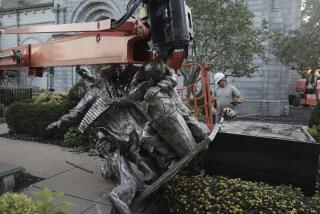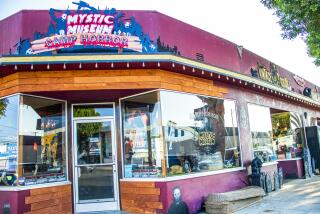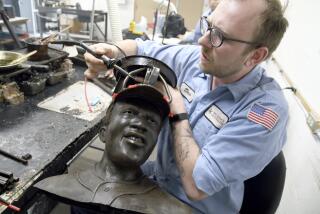Stolen icon travels a well-worn trail
ATHENS — She first noticed the slivers of glass.
Strange, the nun thought, we always sweep the floors after the last pilgrims and miracle-seekers are ushered out before dusk.
Then it all became terribly clear.
A smashed window. Candles toppled over. And an arch-shaped hole where the Elona Monastery’s greatest treasure had been pried from its cradle of pine and resin.
The mother superior ran to the Greek Orthodox priest assigned to the monastery for the busy week around the Aug. 15 feast day of the Virgin Mary, when thousands come to see the 700-year-old icon of the Madonna and Child that some believe has graced their mountainous patch of southern Greece with miraculous powers.
“It’s gone,” she gasped. “Our icon is gone.”
Police arrived within minutes. Nervous local politicos soon joined them. The sunrise was just cresting the Aegean Sea horizon, making the cinnamon-hued limestone cliffs around the monastery blush apple red. A mountaineer’s rope hung limp against the rock face. Down it went -- 130 feet -- to a thicket of chestnut trees, holly bramble and shepherd paths.
Somewhere in these woods during the night -- aided by the weak light of a quarter moon -- the thief slipped away with the icon, police say.
“When the icon was gone,” said the mother superior, “the monastery became like a cemetery.”
Time of the essence
In the dark world of art theft, religious items are some of the hottest commodities -- driven partly by the same insatiable interest in mysteries of faith that catapulted “The Da Vinci Code” to international fame and created a sensation around the recent “Gospel of Judas.”
Experts in art theft say the best chance for recovery is before an object enters the international black markets, which are awash in objects from every major faith and culture.
Greece is not an easy place to contain a thief on the run. Its borders are notoriously porous. It would be easy to stash the icon on a boat to Turkey. Or carry it to Bulgaria or Albania along the routes used by drug mules and human traffickers. The actual icon is small -- 16 by 20 inches -- and is fitted behind an ornamental facade of burnished gold and a heavy frame.
Photos and details of the icon were posted on Interpol’s stolen-art watch list.
Such crimes have been going on since the tomb raiders and relic traders of antiquity. Yet now there’s a borderless buyers’ market with deals being made on cellphones and e-mail.
The collapse of the Soviet Union and the Yugoslav wars brought a flood of looted Christian works -- including icons, chalices, crosses and gilded iconostases, or altar walls -- into a black market already heavy with objects from places such as Eastern Europe and Turkish-occupied northern Cyprus. The wars in Iraq and Afghanistan drew an unprecedented wave of Muslim and pre-Islamic artifacts and cultural patrimony. Recently, investigators have noticed a surge in stolen works from Latin America and Southeast Asia, such as Buddhist ceremonial figures and pre-Columbian sacramental pieces.
“It’s a phenomenon that is now so widespread,” said Jennifer Thevenot, a spokeswoman for the Paris-based International Council of Museums, which works with Interpol and other agencies on art theft issues. “It affects all regions and all religions.”
Interpol and the U.N. cultural heritage agency UNESCO call stolen art the No. 3 illegal market behind drugs and arms trading.
Interpol statistics offer some guidance. For 2004 -- the most recent data available -- nearly 1,800 thefts were reported from places of worship, led by Italy and Russia. For the same period, there were 334 museum thefts and 291 from dealers or galleries.
By midmorning Aug. 19, forensic teams at the Elona Monastery had found DNA traces. Roadblocks were set up around the nearby regional center of Leonido, about 120 miles southwest of Athens. Helicopters buzzed through valleys and around the 4,000-foot peaks on the Parnonas Range.
“It was a matter of honor for us to find the icon and the culprits,” said the head of the Greek national police, Anastasios Dimoschakis, whose teams quickly pieced together a theory on the burglary.
The thief -- or thieves -- most likely entered the monastery with pilgrims and then hid until dark. Only one window to the chapel is without bars. That’s because it looks out on a vertical drop of almost certain death. But that was the way both in and out. Footprints and smudges from the rope showed the daring descent along the whitewashed walls.
Inside the chapel, an outer barrier of glass was smashed to reach the small chamber with the icon. The icon was chiseled out of its base with crisp precision.
The icon must have been stashed in a backpack, police guessed. It would be far too risky for a one-handed descent from the cliff.
How legend grew
The precise origins of the icon are lost to time.
Most scholars say it dates from the 14th century and is rendered in a style common to Greek icons since early Byzantium: Mary wearing red robes and crown; the infant Jesus with a halo containing alpha and omega -- the first and last letters of the Greek alphabet. But for centuries, only the icon’s two faces have been visible from behind an ornate covering of gold and jewels.
The icon’s fame grew along with local lore about the founding of the monastery, which tradition says was built after shepherds saw an icon glowing on the cliffs. The stories of the icon’s miraculous powers spread during the Ottoman Muslim rule, including a still-told tale about how it blinded Turkish soldiers who wanted to destroy the monastery.
Many museums and important cultural sites have steadily improved surveillance and safeguards of their collections. But places of worship and religious reflection -- often holding unique treasures -- face a quandary: how to maintain sanctity without becoming too sterile or controlling.
“At some villages, there is not enough money for any security at all,” said Yevgeny Mikhailovich Strelchik, an expert in efforts to protect Russia’s religious art heritage.
Some Russian churches, he said, have followed examples in Europe and imposed museum-grade security on its main treasures. A new proposal calls for placing identity chips in icons and other important religious objects that would allow agents to track items with auction houses and dealers.
Expanded international cargo checks and cooperation since the Sept. 11, 2001, terrorist attacks also have made it harder to move stolen works, officials say. There have been some notable successes.
Since late 2002, more than 250 stolen Russian icons and other religious objects were returned by Italian authorities. But the lure of the black market remains strong. An icon was among more than 200 items reported stolen from St. Petersburg’s famed Hermitage Museum in July. The icon was later found in a trash bin as police pressure mounted.
In the U.S., there’s evidence of greater traffic in religious antiquities from Latin America and pre-Islamic artifacts from Iraq looted in the lawlessness after the U.S.-led invasion in 2003.
In April 2004, U.S. Immigration and Customs Enforcement agents seized a 500-year-old altarpiece stolen in 2001 from a convent in Puebla, Mexico. It was being sold for $225,000 in an art consignment shop in Santa Fe, N.M. Authorities in the United States, Jordan and other nations have seized more than 5,000 objects looted from Baghdad’s National Museum in 2003.
Pressure has also increased on curators, dealers and auctioneers to determine whether an object is stolen. The London-based Art Loss Register, a global clearinghouse of stolen works, has grown to nearly 180,000 entries going back to World War II. About 10% are religious pieces.
“There’s a lot more sensitivity about making all efforts to find out whether an object is stolen,” said Mieke Zilverberg, chairwoman of the International Assn. of Dealers of Ancient Art based in Amsterdam. “There will always be a black market. We are trying to make it smaller.”
Finally, a break
Nearly five weeks after the Elona icon theft, Greek police got a break.
They intercepted a phone call and had a suspect: a 28-year-old Romanian man. Yes, he said over the phone, I have the icon. It is safe. Let’s discuss a price.
Police say the suspect had been in contact with a private collector in Athens. But any deal apparently fell apart. He then moved on to a bishop in southern Greece. A ransom price was set at $1.28 million, police said.
Agents moved in Sept. 21 during a rainstorm. The suspect was at home in the village of Farklo near the southeastern tip of mainland Greece. The icon was found hidden in a stone wall of a nearby church, protected by some old clothes and a wooden box. It was not damaged.
Police also found more than 230 pieces of jewelry and other offerings left by worshipers at the monastery. The suspect had video and photographs of the icon apparently taken on a visit to plan the robbery, police said.
Police say the Romanian confessed to the robbery, but no other details have been made public. The investigation is not over, officials said.
On Oct. 1, the icon returned home. Thousands of people lined the narrow road to the monastery. An honor guard snapped to attention as the icon was carried on the last leg by Greece’s public order minister, Vyron Polydras. Worshipers showered him with flower petals.
Bars are planned for the window facing the cliff.
More to Read
Sign up for Essential California
The most important California stories and recommendations in your inbox every morning.
You may occasionally receive promotional content from the Los Angeles Times.










